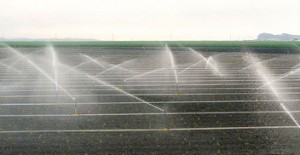Looking toward Monterey: NCPH's 2014 Call for Proposals
24 May 2013 – Cathy Stanton
“Sustainable Public History”
2014 Annual Meeting, National Council on Public History
Monterey, California, March 19–22, 2014
Call for Proposals

Irrigating fields north of Monterey. (Photo: Richard Masoner/Cyclelicious) Fresh water is an increasingly scarce resource in California as in much of the American West.
In 2014 the National Council on Public History will meet at the Monterey Conference Center. Monterey is one of California’s most naturally beautiful and historically rich cities. The Conference Center is adjacent to the original Presidio of Monterey, founded in 1776. And it’s a short walk to historic Colton Hall, site of the signing of California’s first constitution. A paved bayside recreation trail leads to Cannery Row with its shops, galleries, IMAX Theatre, restaurants, clubs and the spectacular Monterey Bay Aquarium. Monterey is a city where nature and culture intersect in fascinating and challenging ways, an ideal place to explore issues of sustainability.
The program committee invites panel, roundtable, workshop, working group, and individual paper proposals for the conference. The Call for Poster sessions will be issued in fall 2013.
The Call for Proposals closes July 15, 2013.
At its core, sustainability means meeting the needs of the present without compromising the future. Sustainability requires us to work within limited economic and natural resources, build lasting community and cross-disciplinary relationships, emphasize quality over quantity, and elevate social responsibility. The idea of sustainability is often applied to our relationship with the environment, but also relates to the way we manage and fund historic resources. This conference will examine how the idea of sustainability can advance the field of public history and, in turn, how public history can encourage sustainability. Questions to consider include:
- How can we use history to promote a better relationship with the environment?
- How can we ensure that our own work is sustainable and that the collections, institutions, and knowledge we build today will endure for generations?
- Recognizing that disparities of wealth and power undermine sustainability, how can we use history to ensure social justice?
- How can public historians connect local actions to global developments, particularly around processes like climate change or economic decline and redevelopment?
- How can our work inform vital public debate on these processes?
Some ideas for sessions include:
- Interpreting the history of energy resources and their use, climate change, global warming, consumption, transportation, and the material culture of waste and reuse
- Sustainable food – historic foodways and local food culture, historic farming practices and modern agriculture, farmers’ markets, community gardening
- Preserving and interpreting historical resources in an era of climate change and limited resources, including resources that have themselves altered the environment
- The role of historic organizations and preservation in sustainable planning or rebuilding – how are historic communities rebuilding after hurricanes and other disasters? How should municipalities manage use of waterfronts, flood plains, or areas susceptible to drought, etc.?
- Reuse of historic buildings, issues of integrity, and the relationship between “green” architecture and historic preservation
- Developing and interpreting the heritage aspects of recreational trails and environmental preserves
- Graduate education: What do graduate students need to know about sustainability? Is the proliferation of graduate programs sustainable?
- Incorporating public history into university-based sustainability centers or councils
- Understanding sustainability issues in digital history projects
- Cultivating and sustaining community engagement relationships
- The impact of heritage tourism on communities and the natural environment
- Race relations – neighborhood segregation and connections to environmental justice on the Monterey Peninsula and elsewhere
- Creative ways to sustain heritage institutions; finding new audiences and new funding sources
- Diversifying the public history profession
For more on types of sessions and guidelines for developing your proposal, visit the NCPH website.
If you have questions, please contact the program committee co-chairs or the NCPH program manager.
2014 Program Committee Co-Chairs
Briann Greenfield, History Department, Central Connecticut State University
Leah Glaser, History Department, Central Connecticut State University
NCPH Program Manager
Stephanie Rowe



